In yesterday’s Advisor, we presented some of the results of our 2015 Performance Management Survey; today, the rest of the results, including the role of HR and the top five errors supervisors make.
 |
1,198 individuals participated in the survey, conducted in May 2015.
Forms and tools
Basically the same form is used for all or almost all employees at the organizations represented by 47.4% of our survey participants. Different forms for different departments or positions are used by 19.8%, and different forms for exempt vs. nonexempt are used by 17.9%. Management appraisals are conducted using a different form than the one used for nonmanagement employees by 20.1%, and 2.6% have no standard form.
Appraisal forms with ratings/scales work well for 79%, and essay questions work for 26.9%. Multiple choice review statements/questions work well for 15.1%, and 6.9% like yes/no statements/questions.
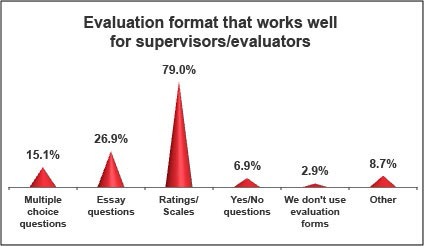
Performance Appraisals
Performance review software is not an option for 63.4% of survey participants, and 6.4% have no performance appraisal software but are interested in learning more about it. Software is used by 15.3% with good results, but using it hasn’t improved the process for another 8.7%. A small group (1.6%) has looked for such software but found nothing that meets their needs.
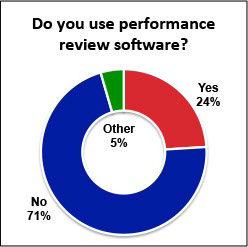
When it comes to what kind of software is used, the responses in our survey are all over the map. ADP and in-house developed software tie at 11.6%. Success Factors is used by 11%, Halogen eAppraisal is used by 7.1%, and PeopleSoft is used by 6.1%. The largest group, however, is the “other” basket at 34.5%.
It’s the third HR Playbook from BLR®! Read the new guide, The Total Rewards Framework: Build Loyalty, Engagement, and Retention, and find out how to give employees what they most value.
Employees’ role
When setting individual performance pay factors, employees are heavily involved for 8.5% (up from 6.8% in 2014) of our survey participants and somewhat involved for 19.3%. They are minimally involved for 20.6% (16.3% in 2014) and not involved at all for 51.6%.
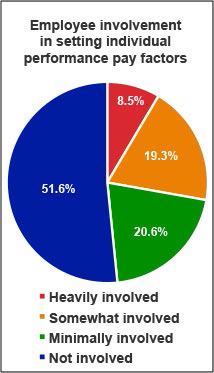
When it comes to whether employees have sufficient impact on individual performance factors that affect their pay, 49.9% believe they do, and 31.1% believe they do not. The remaining 18.9% are not sure. Interestingly, when asked if the employees in their organizations are pleased with their individual pay-for-performance programs, 26.4% indicate they are, and 36.7% indicate that they are not. The remaining 36.8% aren’t sure one way or the other.
Supervisors’ role
Management’s top responsibilities when it comes to performance evaluations are writing evaluations of their direct reports for 81.8% of survey participants, followed closely by setting goals for/with employees for 73.8%, conducting review meetings for 73.8%, and coaching employees for improved performance for 71.2%. Finishing out the field are reviewing evaluations prepared by their direct reports for their own employees (62.6%), deciding employee salary raises (49.3%), and providing input to other supervisors on their direct reports (37%).
The errors performance evaluators make include not completing the evaluation (20.2%), halo effect (23.4%), and horn effect (17%). The three most common errors are:
- Not following up with employee to check on progress, 45.6%
- Being late in completing evaluation(s), 40.8%
- Focusing on the most recent performance rather than the entire review period, 38.6%
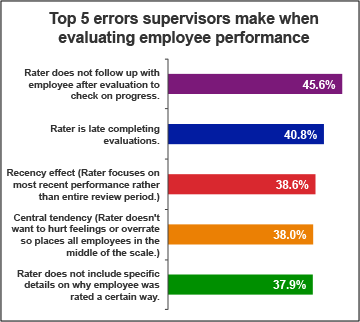
Supervisors never receive discipline or poor marks for poorly executing performance appraisals for 37% of survey participants and only rarely for 34.1%. Training for supervisors on how to evaluate performance and conduct appraisals is offered annually by 25% and never for 27.5%.
When asked how they’ve successfully implemented performance appraisal programs, survey participants provided several helpful hints, including:
- Communication and follow-up, 61.5%
- Send reminder e-mails, 55.2%
- Offer assistance as needed, 39.8%
- Track who has turned them in, 35.8%
- Tie to supervisor/manager job performance, 28.5%
- Train individually as requested, 27.8%
- HR is involved in each evaluation, 25.1%
- Have management review after supervisor has completed, 18.5%
- Make evaluation forms shorter, 16.6%
- No evaluations turned in means no raise given, 10.1%
- Publish a false deadline that is 2 weeks before they are really due, 7.6%
HR’s role
HR’s responsibility for the performance appraisal process varies, but several functions were widely practiced, including:
- Formal training for supervisors/evaluators, 48.4%
- Filing the paperwork, 49.2%
- Reviewing all evaluations, 52.7%
- Informal coaching for supervisors/evaluators, 54.7%
Additionally, for 39.4% of survey participants, HR screens performance evaluations for anything that might be illegal before supervisors/managers meet with employees.
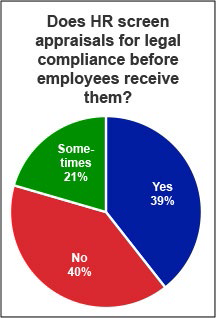
Merit increases
Evaluations are tied to most salary increases for 42.5% and are completely separate for 20.8%. They are partially tied together for 31.1%. Those who separate evaluations from increases do so because:
- A union agreement governs pay increases, 7.8%
- Evaluations are conducted more frequently than raises are issued, 8.4%
- They fear supervisors will be tempted to give good yet false appraisals so employees receive a good raise, 15.4%
- Budget doesn’t allow for raises every time employees receive evaluations, 16%
- Employee pay increases are on a different schedule than evaluations, 17.8%
- Appraisals are more valuable and constructive if raises aren’t tied to them, 18.6%
- It helps keep employees from having an entitlement mentality (evaluation = raise), 25.7%
- They want to focus attention on employee performance instead of on amount of raise, 31.4%
Even if salary increases are not an option due to pay freezes or some other reason, 79.6% (down from 84.6% in 2014) of survey participants still conduct performance appraisals.

Thanks again to all who participated!
Merit increases are just a part of total employee rewards. It’s easy to think of total rewards as just “pay and benefits”—but there’s so much more to it than that. It’s the totality of the employment experience, including coworker culture, company ethos, and a great deal of other factors. The big question is: What do employees really want, and how can employers give it to them? You’ll find the strategies you need in the new guide, The Total Rewards Framework: Build Loyalty, Engagement, and Retention.
This third HR Playbook from BLR provides practical guidance on everything from effective compensation strategies to innovative benefits to perks and rewards—and how HR can combine them to not simply retain, but engage.
Rewards are about more than just pay and benefits! Find out everything you need with the new HR Playbook, The Total Rewards Framework: Build Loyalty, Engagement, and Retention. Find out more or order here!
You’ll learn practical guidance on building a solid total rewards program, including:
- Implementing your total rewards framework
- Developing your compensation strategy
- Challenges and options regarding variable pay and benefits
- Perks and rewards (many at low or no cost)
- How to reward different categories of employees effectively
- And much more!
You value your employees—be sure they know just how much. Start strategizing today with The Total Rewards Framework: Build Loyalty, Engagement, and Retention.
